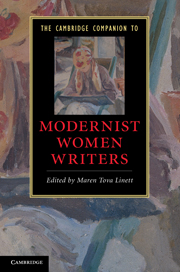Book contents
- Frontmatter
- Modernist women’s literature: an introduction
- 1 Transforming the novel
- 2 Modernist women poets and the problem of form
- 3 Women’s modernism and performance
- 4 Magazines, presses, and salons in women’s modernism
- 5 Gender in women’s modernism
- 6 Black women’s modernist literature
- 7 Race and ethnicity in white women’s modernist literature
- 8 Geomodernism, postcoloniality, and women’s writing
- 9 Women modernists and visual culture
- 10 Modernism and trauma
- 11 Political activism and women’s modernism
- 12 Religion and the occult in women’s modernism
- Guide to further reading
- Index
12 - Religion and the occult in women’s modernism
Published online by Cambridge University Press: 28 November 2010
- Frontmatter
- Modernist women’s literature: an introduction
- 1 Transforming the novel
- 2 Modernist women poets and the problem of form
- 3 Women’s modernism and performance
- 4 Magazines, presses, and salons in women’s modernism
- 5 Gender in women’s modernism
- 6 Black women’s modernist literature
- 7 Race and ethnicity in white women’s modernist literature
- 8 Geomodernism, postcoloniality, and women’s writing
- 9 Women modernists and visual culture
- 10 Modernism and trauma
- 11 Political activism and women’s modernism
- 12 Religion and the occult in women’s modernism
- Guide to further reading
- Index
Summary
In 1887, Madame Blavatsky arrived in London to publicize her occult philosophy, a heady mix of Neo-Platonism, Buddhism, and Kabbalistic mysticism. Despite accusations of fraud from the Society for Psychical Research, Helena Blavatsky's Theosophical Society flourished, reflecting the renewed interest in spiritualism in the 1880s. Reacting against the rise of Darwinism and a society increasingly devoted to scientific and technological progress, spiritualism developed as a counter-cultural movement in which women were dominant as teachers and mediums. Annie Besant, lampooned by Virginia Woolf in The Waves (1931), is just one example of someone who combined campaigning for women's rights with active involvement in the Theosophical Society. The alliance of spirituality and feminism was empowering, as is evidenced in the work of New Woman writers at the turn of the century, when writers like Sarah Grand and George Egerton took up the theme of women's superior spiritual powers in fiction that foreshadows the modernist aesthetic with its emphasis on dreams, the subconscious, and formal stylistic experimentation. Egerton's short stories in Keynotes (1893) and Discords (1894) resist social constructs of femininity, allying women instead with nature, the primitive, and the spiritual in a way that anticipates the work of female modernists. Her writing reveals distaste for organized religion, particularly the Irish Catholicism of her youth, and her argument that women's maternity privileges them over men anticipates Jane Harrison's influential work on early matriarchal civilizations.
- Type
- Chapter
- Information
- The Cambridge Companion to Modernist Women Writers , pp. 187 - 202Publisher: Cambridge University PressPrint publication year: 2010
- 3
- Cited by

